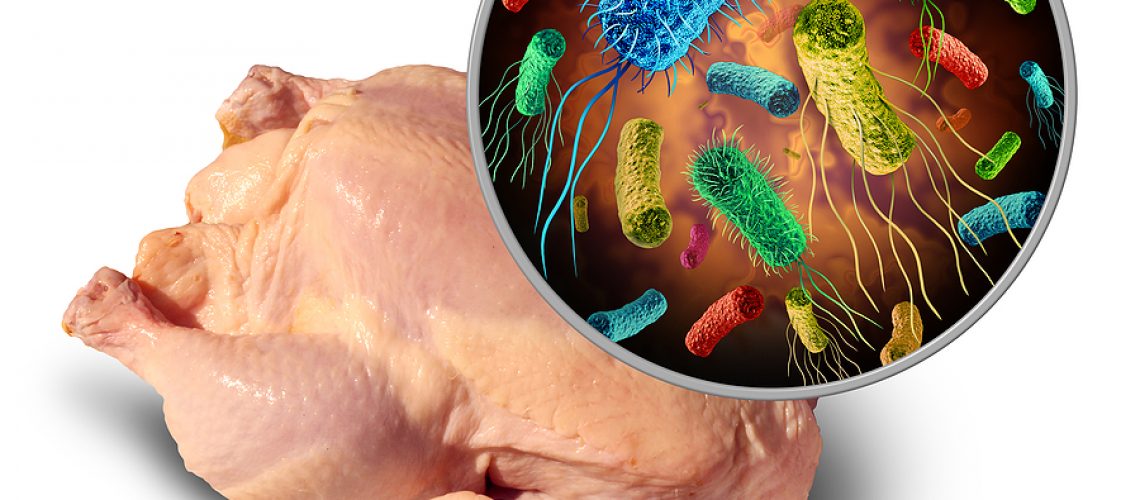To reduce human illnesses, Food Safety and Inspection Service (FSIS) department has announced that it is considering a new strategy for the agency to control salmonella in poultry products, which sickens at least 100,000 people each year, according to the Centers for Disease Control and Prevention.
Some who have been fighting for Salmonella to be controlled are feeling lukewarm about the de possibility, like Bill Marler, a food safety attorney who filed a petition on behalf of three consumer groups seeking to have Salmonella declared an adulterant.
“This is the first public-facing document I’ve seen in more than 30 years that FSIS has put out there showing that they understand there is a problem,” Marler declared.
Brian Ronholm, the director of food policy at Consumer Reports, said that he is also happy to see the process in the petition “It’s critical for the USDA to work expeditiously to adopt aggressive goals to sharply reduce salmonella contamination and focus its efforts on reducing the strains that pose the biggest threat to human health.”
One of the main reasons for Salmonella be widespread in chicken is because of the poor conditions in which they are raised and even though there has been some progress in reducing the percentage of poultry infected by Salmonella, Salmonella in poultry has remained for years with at least 50 percent of chickens infected with Salmonella sickening people.
With the proposed FSIS framework the number of human illnesses caused by Salmonella in poultry would be decreased by 25 percent, meaning three out of four people who are sickened would still get sick. That is not acceptable in Marler’s opinion.
“While the proposed framework represents a welcome shift in thinking by the agency, many important details are yet to be worked out, and the need for these changes is urgent,” said The Center for Science in the Public Intense (CSPI) pleased to see the attention to Salmonella in poultry but facing it with prudence.
“USDA’s announcement of this framework represents a landmark acknowledgment from an agency that has long refused to recognize that Salmonella in raw poultry poses unacceptable risks. Center for Science in the Public Interest first petitioned the USDA to ban certain strains of antibiotic-resistant Salmonella in 2011, and again in 2014, but was denied twice by the agency”.
Organizations like STOP Foodborne Illness are also happy to see FSIS taking action on the problem of Salmonella in chickens.
“Stop Foodborne Illness (STOP) applauds FSIS for taking the first step of developing meaningful, comprehensive controls for Salmonella in poultry that includes an enforceable final product standard. The proposed framework reflects many issues STOP and its coalition partners raised in our joint petition filed in January 2021,” said Mitzi D. Baum, M.Sc. and CEO of STOP.
One key point in the proposed framework for the possible FSIS strategy for dealing with Salmonella in poultry is to have the industry work out the problem. The framework calls for birds to come into “the establishments” cleaner. That means that people who raise chickens would have to send healthy birds to slaughterhouses and processing plants.
By putting pressure on “the establishments” to accept cleaner birds the government believes the slaughterhouses and processors would put pressure on their suppliers, thus resolving the problem.
Marler says the most significant point in the proposed framework is that it recognizes that dealing with Salmonella pre-harvest is necessary. Right now there is no industry incentive to fix the problem.
Consumer Reports agrees that testing so-called incoming birds is a crucial step.
“Under the proposal announced by the USDA, poultry producers would be required to test flocks for salmonella before slaughter and provide documentation on salmonella levels or serotypes to processing plants,” according to Consumer Reports’ statement. “The requirement is meant to incentivize plants to implement measures to reduce the salmonella load in the final poultry product. USDA is also considering the adoption of a final product standard to ensure that poultry contaminated with salmonella likely to make people sick is not allowed on the market”.
The potential framework described in the FSIS announcement is the following:
A key point from the FSIS announcement is that the agency will be seeking comment from stakeholders on all of the elements of the framework — both at a public meeting and in written comments submitted to the meeting docket in the Federal Register — before moving forward with any proposed changes to regulations or other actions.
After analyzing recent data on human illness from the Centers for Disease Control and Prevention and FSIS sampling results from chicken and turkey products, the agency has decided to focus at this time on three serotypes: Enteritidis, Typhimurium, and Infantis2, which together cause 33 percent of all Salmonella illnesses. The public petition requested that 32 types be considered adulterants.
Excerpts from the three components of the framework
Component 1: Requiring incoming flocks be tested for Salmonella before entering an establishment, FSIS is considering requiring establishments to characterize Salmonella as a hazard reasonably likely to occur at receiving and that incoming flocks be tested for Salmonella before entering an establishment.
Under this approach, the flock would have to meet a predetermined target for Salmonella at receiving, which may be industry-wide or establishment-specific, and the establishment must demonstrate that its subsequent process will be effective in reducing Salmonella so that the product will meet the final product standard.
Salmonella enters an establishment in and on the birds. This component aims to incentivize the use of pre-harvest interventions that reduce the level of incoming Salmonella contamination or mitigate the risk of a particular serotype entering the establishment.
Under this approach, FSIS does not intend to require the industry to adopt any specific pre-harvest interventions but would allow flexibility for the industry to adopt the practices that are most effective at controlling Salmonella in each particular operation. Establishments would be encouraged to work with their suppliers and contractors to ensure they are implementing best practices in reducing the Salmonella hazard in breeding facilities, hatcheries, grow-out, and throughout transport.
Component 2: Enhanced Establishment Process Control Monitoring and FSIS Verification
To ensure that poultry slaughter establishments are effectively controlling Salmonella throughout their operations, FSIS may propose modifying its current regulations to prescribe enhanced establishment monitoring procedures, including revised locations for multipoint sampling and a statistical approach to process control.
The second component of this proposed framework builds on Hazard Analysis and Critical Control Point (HACCP), FSIS’ prevention-based approach to food safety. To ensure pathogen control throughout slaughter and processing operations, FSIS may modify the existing requirements for indicator organism testing for process control and establish additional parameters to better define the required analysis of the data. As part of the proposal, establishments may be required to test for indicator organisms (e.g., aerobic plate count [APC], Enterobacteriaceae).
Component 3: Enforceable Final Product Standard
FSIS is assessing whether certain levels or types of Salmonella in raw poultry products present an elevated risk of causing human illness such that they should be considered adulterants. As a result, the agency is considering implementing a final product standard or standards to ensure that product contaminated with Salmonella that is likely to make people sick is not sold to consumers.
To protect public health, FSIS regulations should prevent products with high levels of contamination and/or specific serotypes from entering commerce. This goal would be accomplished by declaring Salmonella an adulterant. In doing so, FSIS would rely on criteria that were applied to STECs. These criteria are consideration of serotypes associated with human illness; low infectious dose; severity of human illnesses; and typical consumer cooking practices.
Beach, C. (2022). USDA has plans to consider whether Salmonella in chicken should be dealt with. Food Safety News. From: https://www.foodsafetynews.com/2022/10/usda-has-future-plans-to-consider-whether-salmonella-in-chicken-should-be-dealt-with/


